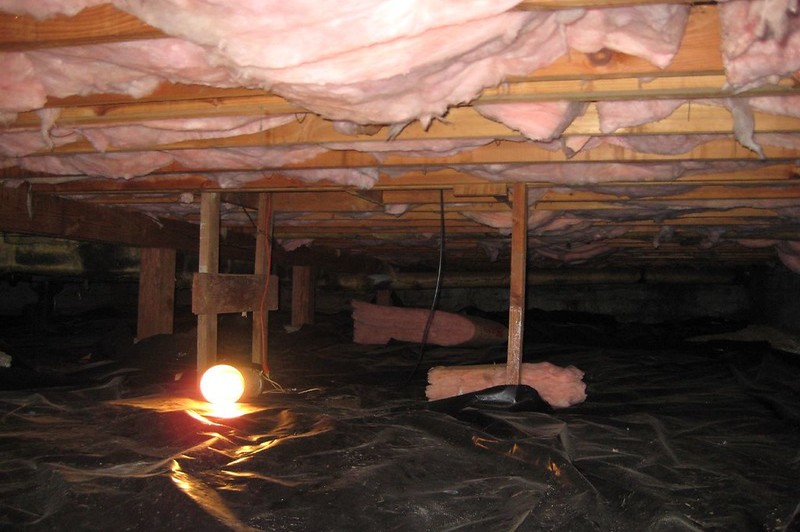Are you wondering how to remove mildew from crawlspaces? We got the answers in this article, so be sure to stay tuned until the end!
The revelation of mildew in a home often causes residents to panic. Mildew, on the other hand, is more common in places.

Because it thrives in a comfortable, moist environment, a crawl space is an ideal place for microscopic spores to settle down and thrive.
Although mildew should be addressed and removed, not all mold is the same. Before you start digging in a dirt crawl space, figure out what kind of mold you have.
Knowing The Type Of Mildew
Mildew comes in a variety of forms that can be found in the home. While you’ll want to get rid of any mildew in your crawl space, knowing what kind of mildew you have will help you determine the best course of action.
Although yellow mold is common, it can be harmful to the materials in the crawl space. Serpula lacrymans, also known as house-eating mold, is a type of mold.
Inside a crawl space, it eats away at the wood material. Yellow mold can be found in the soil of houseplants and other dirt imports into your home.
Aspergillus is a common household fungus that is not harmful to healthy adults. Breathing in aspergillus over an extended period of time might cause respiratory problems in small children and individuals with weakened immune systems.
The Centers for Disease Control, on the other hand, considers aspergillus to be an inevitable airborne fungus. Check out the safety tip in this linked article about what causes mildew smell in walls.
Dangerous Mildew In Crawlspaces
Mildew in a crawl area can cause respiratory problems and other health problems. There are a few germs that are more dangerous than others to be around. These are some of them:
Mildew Type #1. Alternaria is an allergic mold that can trigger wheezing, coughing, sneezing, and other respiratory issues.
Mildew Type #2. Cladosporium is a dangerous fungus that can swiftly cause major respiratory problems in children, the elderly, and asthmatics. This black, creeping mildew can grow on slightly damp dirt and wood, textiles, within HVAC systems, painted walls, mattresses, and food and paper.
Mildew Type #3. The mildew you don’t want to come upon is Stachybotrys. The mold that can grow in a crawl space is the most toxic.
This is the true “black mold,” which is harmful to anyone who comes into contact with it in the dirt, carpet, drywall, subflooring, or insulation. You may want to engage a professional to remove this form of mold so that it does not spread to other parts of the house.
Eliminating Mildew From Crawl Spaces
When people ask us how to get mold and mildew out of crawl spaces, we always emphasize the necessity of human safety. Protect your health with an OSHA-rated respirator or face mask, non-vented goggles, heavy gloves, and disposable coveralls before starting any DIY mold removal operation.
Step #1. Analyze the circumstances
Assess the degree of mold and mildew in the crawl space while wearing your safety gear. Set up lights and place plastic sheets on the floor to catch mold as it is removed from the surfaces.
If the job appears to be too enormous, call a mold removal company immediately. Read this article about how to prevent mildew in cabinets for more safety precautions.
Step #2. Use a foaming spray to clean
Spray the damaged areas with a mold-removal-specific foaming cleaning agent. Allow it to expand and dislodge the mold before wiping the surfaces thoroughly.
Step #3. Use a mold/mildew killer to soak
Using a homemade mold-killing concoction or a mold-removal solvent, soak any leftover thin layers of mold. Commercial products are often more effective, and they can also eliminate mold stains.
Step #4. Remove the residue
Allow afflicted surfaces to dry before scrubbing away any leftover mold with a sharp bristle brush. This can be a lengthy procedure, but you want to get rid of as much mold as possible.
Step #5. Get rid of everything
Fold the plastic sheeting carefully and seal it in a hefty garbage bag. Coveralls, brushes, and any other contaminated equipment should be disposed of in the same manner.
Step #6. Control the temperature in crawl spaces
There are a few various ways to deal with the environment in your crawl space, but a dehumidifier is generally a more effective and cost-effective option.
Consider setting up a model that can function in confined spaces. Make crawl space examination a regular component of your home’s spring and fall upkeep.
Conclusion
Mold and mildew is a part of our natural ecosystem, but it has no place in your crawl space. As it feeds on the structural components directly beneath your home, even a little patch quickly spreads.
Mold and mildew in the air can spread throughout the house, affecting the health of everyone living upstairs. Mold is not tolerated at any level in a crawl space.
Don’t take on work that’s too big or too dangerous, no matter how confident you are in your DIY abilities. That will wrap everything on how to remove mildew from crawlspaces.
